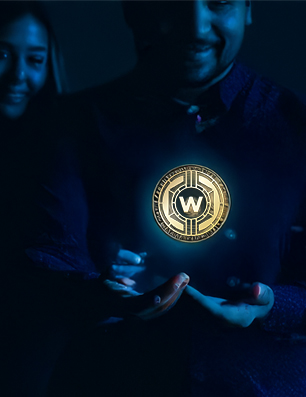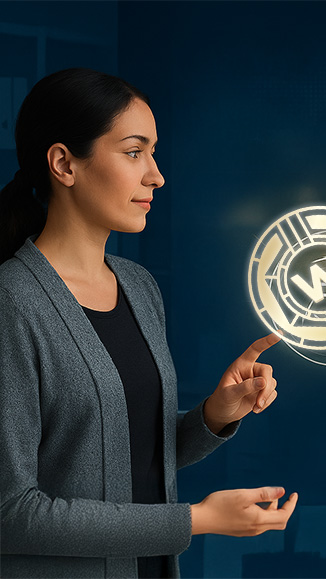- Written by: Annie Izockey
- Wed, 21 May 2025
- Czech Republic
What is blockchain? How does blockchain work? Is blockchain secure? Find answers to blockchain basics explained in simple terms. The post Blockchain Explained: What It Is, How It Works and Why We Need It appeared first on Cryptocurrency News & Trading Tips Crypto Blog by Changelly.
Blockchain Explained: What It Is, How It Works and Why We Need It
If youve ever wondered what is a blockchain, youre not alone. This once-niche concept is now at the center of how were rethinking digital trust. Whether youre storing medical data, verifying steps in a supply chain, or managing transaction records on the Bitcoin blockchain, blockchain is reshaping how information flows. But how do blockchain systems actually work? And why is this form of distributed ledger technology so important across industries? This article breaks it all down in plain terms.
What Is Blockchain Technology?
Blockchain is a decentralized digital ledger that records data across multiple computers. No single person or group controls it, and everyone on the network shares access to the same information.
Picture a notebook passed around a group. Each person writes down their transaction. When a page fills up, its sealed and glued to the previous one. You cant change past pages without tearing the whole notebook apart in front of everyone. Thats how blockchain ensures transparency and security.
Blockchain networks are built from blocks, each containing a list of verified transactions. These blocks link together in a chronological chain. Once added, data becomes nearly impossible to change without rewriting every block that comes after it. Thats what makes blockchain tamper-resistant.
There are two main types of blockchains: public and private. Public blockchains, like Bitcoin or Ethereum, are open to anyone. Private blockchains restrict participation and are often used by businesses for tasks like supply chain tracking or internal audits.
Finally, behind everything are cryptographic algorithms. These secure each transaction and verify data without a central authority. This design builds trust through transparency and shared control.
What Is The Point of Blockchain?
The core purpose of blockchains is to create trust without intermediaries. You dont need a bank, government, or third party to confirm a transaction: instead, the network verifies each one through consensus algorithms. This enables people and businesses to exchange assets securely and directly. These assets can include cryptocurrency, digital contracts, or even property records.
Businesses also use blockchain to automate complex workflows. Smart contracts, for example, execute automatically once predefined conditions are met. No intermediaries, no delays.
Blockchain technology is designed to build secure, transparent, and efficient systemsespecially when trust is essential.
How Blockchain Differs from Traditional Databases
Traditional databases rely on centralized control. A single organizationoften a bank, government agency, or corporationmanages the system, controls access, and approves all changes. This structure works well in many industries, but it creates a single point of failure and demands trust in the authority running the database.
Blockchain technology flips that model. Instead of one central administrator, it distributes control across a network of participants. Each participant holds a complete copy of the ledger. Theres no master version, and everyone sees the same data in real time.
Security on blockchain networks is handled through cryptographic methods. A hash function transforms transaction data into a unique, fixed-length string. Even a minor change in the input produces a completely different hash, exposing any tampering instantly. Paired with that is the private keya digital signature unique to each user. Only the private key holder can authorize a transaction, and the network can verify it without needing to see the key itself. This is how blockchain ensures authenticity, especially in systems handling bitcoin transactions.
Traditional databases allow authorized users to edit or delete records. Blockchain doesnt. Once data is recorded in a block and added to the chain, it cant be changed. This immutability makes blockchain especially valuable for systems that need to record transactions with full transparency and permanence.
Key Components of Blockchain Networks
Blockchain networks rely on a few essential components. Together, they make the system secure, transparent, and resistant to manipulation.
Blocks
Blocks are the building units of a blockchain. Each one contains a group of verified transactions, a timestamp, and a cryptographic hash that links it to the previous block. This connection forms a continuous, chronological chain. Once a block is added to the chain, its contents are locked in. If you try to change anything, the hash changesbreaking the chain and alerting the network. This is why blockchains are considered tamper-resistant by design.
A block also includes a nonce, or a random number used during the mining process, and a Merkle root, which summarizes all transactions inside the block. These elements help the network validate the blocks integrity.
Become the smartest crypto enthusiast in the room
Get the top 50 crypto definitions you need to know in the industry for free
Nodes
Nodes are the individual computers or devices that maintain the blockchain. Each node stores a full or partial copy of the entire ledger. Some nodes also help validate transactions or mine new blocks.
Nodes operate under shared rules. They communicate with one another to stay synchronized and reach consensus. In public blockchains, anyone can run a node. In private blockchains, access is restricted to approved participants. These nodes dont just store datathey enforce the rules of the network. If a bad actor tries to submit a fraudulent block, other nodes reject it automatically. This constant verification makes the system self-regulating and highly secure.
Networks
The blockchain network is the ecosystem formed by all active nodes. It operates on peer-to-peer architecture, meaning theres no central server or controller. Every node communicates directly with others to share data and confirm transactions. This structure improves reliabilityif one node goes offline, the others continue operating. The network remains functional and secure, even during disruptions.
Key Features of a Blockchain
Blockchain has three core features that set it apart from traditional systems.
- Decentralization
No single entity controls the network. Every participant holds a copy of the ledger and helps validate transactions, which removes the need for a central authority and increases system reliability. - Immutability
Data on a blockchain cant be changed or deleted. Each block is linked to the previous one using a cryptographic hash. Any tampering breaks the chain and is rejected by the network. - Transparency
All participants see the same transaction history. Public blockchains allow anyone to verify data in real time. This visibility builds trust and accountability.
How Does Blockchain Work?
At its core, blockchain is a type of distributed ledger technology. It records and shares data across a network of computers, rather than storing it in one place. Heres how the process works from start to finish.
- A Transaction Is Initiated
Someone initiates a transaction. This could be sending cryptocurrency, updating a digital contract, or logging asset data. In the case of the Bitcoin blockchain, for example, this means transferring Bitcoin from one wallet to another. - Transaction Data Is Broadcast to the Network
The transaction is shared with all participants, or nodes, in the network. Each node receives the same information at the same time, helping ensure consistency. - The Network Verifies the Transaction
The network checks the transaction using a consensus mechanism. This could be proof-of-work, proof-of-stake, or another method depending on the blockchain type. Once verified, the transaction is considered valid. - A New Block Is Created
Valid transactions are grouped together and packaged into a new block. That block includes a timestamp, a reference to the previous block, and a cryptographic hash that secures the data. - The Block Is Added to the Chain
The block is attached to the chain in a specific order. Once this happens, the information becomes part of the permanent blockchain record. It cant be changed or removed. - The Ledger Updates Across the Network
Every node updates its version of the blockchain. Because all copies match, theres no need for manual reconciliation. This is what makes the system both fast and trustworthy.
All types of blockchain networks use the same fundamental process. What changes is whos allowed to participate and how transactions are verified.
Types of Blockchains
So, what are the different types of blockchain networks, you may ask? Is it proof-of-stake and proof-of-work? Well, not exactly. Those are consensus mechanismsthe rules used to verify transactions. The type of blockchain network describes who can access the system and how it manages data.
Public Blockchains
A public blockchain network is open to everyone. Anyone can join, validate transactions, and access the blockchain data. These networks operate in a fully decentralized way. No single entity controls the system.
Public blockchains are best for transparency and security. The most well-known example is the Bitcoin networkit allows anyone to send or receive cryptocurrency and audit transactions in real time. These networks are often used for decentralized finance (DeFi), digital assets, and public records.
Private Blockchains
A private blockchain network is closed and permissioned. Only approved participants can join and validate transactions. A single organization usually manages it.
Private blockchains are ideal for business networks and internal enterprise solutions. They let companies control access while keeping sensitive data secure. Financial institutions often use private networks to process transactions, settle trades, or manage compliance workflows.
Consortium and Hybrid Blockchains
A consortium blockchain is a semi-decentralized system managed by a group of organizations rather than one. A hybrid blockchain combines elements of both public and private networks, allowing for flexible access control.
These models are useful when multiple entities need to collaborate securely. A consortium blockchain network can support supply chain tracking, interbank transactions, or healthcare data sharing. Hybrid blockchains are useful for industries that want public verification but still require some level of privacy and control.
Consensus Mechanisms
Consensus mechanisms keep a blockchain secure and consistent. They ensure that all nodes agree on whats valid without relying on a central authority. Different blockchains use different methods depending on their goals, which can range from energy efficiency to increased speed or more decentralization.
Proof-of-Work (PoW)
Proof-of-work is the original consensus mechanism. Its known for being secure but resource-intensive. Participants, called miners, compete to solve complex math problems. The first one to solve a problem gets to add a new block to the chain and earns a reward. This process requires significant computing power and energy.
Example: The Bitcoin network uses PoW. Its the most secure blockchain but also criticized for its energy use. Ethereum also used PoW until it moved to PoS in 2022.
Proof-of-Stake (PoS)
Proof-of-stake is a more energy-efficient alternative to PoW. It selects validators based on the amount of cryptocurrency they hold and are willing to stake. Validators lock up tokens as collateral. The protocol chooses one of the validators to verify the next block, often randomly but weighted by the stake. Misbehavior leads to slashinglosing some or all of the staked funds.
Example: Ethereum now uses PoS after the Merge, which reduced its energy use by over 99%. Polkadot, Avalanche, and Solana are other examples of PoS blockchain projects.
Read more: PoW vs PoS.
Proof-of-Authority (PoA)
Proof-of-authority is a permissioned consensus model used in private or consortium blockchains. It relies on trusted entities rather than open participation. A small group of approved validators creates new blocks. These validators are known and vetted, which makes PoA fast and predictable, but less decentralized.
Example: VeChain uses PoA to power supply chain applications, enabling quick and efficient validation.
Delegated Proof-of-Stake (DPoS)
DPoS is a variation of proof-of-stake that introduces a voting system to increase efficiency and scalability. It involves token holders voting for a small number of delegates who validate transactions and create new blocks on their behalf. This makes block creation faster and more democratic but still requires active participation from the community.
Example: EOS and TRON both use DPoS to achieve high throughput and low fees, making them popular for dApps and games.
What Are Blockchain Protocols?
A blockchain protocol is the rulebook that defines how a blockchain network operates. It controls how data is structured, how transactions are verified, how participants interact, and how the system stays secure.
Protocols like Ethereum and the other examples below arent just platformstheyre entire systems that make blockchain technology work. Each one is designed for specific goals, whether thats powering digital currencies, enabling smart contracts, or supporting private enterprise solutions.
These protocols form the foundation of any blockchain implementation, shaping how users build, interact, and trust the network.
Hyperledger Fabric
Hyperledger Fabric is an open-source enterprise blockchain platform developed by the Linux Foundation. It is designed for use in private and consortium networks, offering modular architecture and permissioned membership.
Hyperledger Fabric enables businesses to create private blockchain networks tailored to their specific needs. It supports smart contracts (chaincode) and allows for confidential transactions, making it suitable for industries like supply chain management, healthcare, and finance. As of 2025, Fabric has introduced Fabric-X, a purpose-built implementation aimed at next-generation digital assets, enhancing its capabilities for enterprise blockchain solutions .
Ethereum
Ethereum is a decentralized, open-source blockchain platform that supports smart contracts and decentralized applications (dApps). It transitioned from Proof-of-Work to Proof-of-Stake in 2022 to improve energy efficiency.
Ethereum serves as the foundation for a vast ecosystem of dApps, DeFi platforms, and NFTs. In 2025, Ethereum implemented the Pectra upgrade, incorporating 11 improvement proposals to enhance transaction speed, reduce costs, and improve staking flexibility.
Solana
Solana is a high-performance blockchain known for its scalability and low transaction costs. It utilizes a unique combination of Proof-of-History and Proof-of-Stake consensus mechanisms. Solana is widely used for decentralized finance, NFTs, and gaming applications.
Quorum
Quorum is an enterprise-focused blockchain platform originally developed by JPMorgan Chase and later acquired by ConsenSys in 2020. It is built on Ethereum and tailored for business applications requiring privacy and performance.
Quorum supports private transactions and permissioned participation, making it suitable for financial institutions and enterprises. It is used in applications like JPMorgans Interbank Information Network (IIN), now known as Liink, facilitating cross-border payments among over 400 financial institutions. Additionally, JPM Coin, a digital currency developed by JPMorgan, operates on the Quorum platform to enable instantaneous payment settlements between institutional clients.
Challenges, Risks, and Strategic Considerations of Blockchain Technology
Blockchain technology promises transparency and decentralization, but it also naturally comes with certain trade-offs.
Technical Challenges
Scalability is a core issue. A single Bitcoin transaction can take minutes and cost dollars. Even the Ethereum blockchain, though faster, still struggles with congestion and high gas fees.
The blockchain database is constantly growing. Every node must store all of its data, which limits participation. Bugs in smart contracts can also lead to loss of funds with no recovery. These problems slow down blockchain adoption across real-world sectors like finance and logistics.
Regulatory and Compliance Risks
Regulation hasnt kept pace with innovation. Most blockchain users operate under unclear or conflicting laws, especially around asset handling and record transactions.
Permanent data stored on-chain may violate privacy laws like GDPR. For traditional business networks, legal uncertainty is a major barrier to using blockchain protocols in production.
Interoperability and Standards
Blockchains often work in isolation. Moving data or assets across networks is difficult. This fragmentation limits large-scale blockchain implementation and integration with legacy systems. Without shared standards, a blockchain protocol cant easily support cross-network workflows or enterprise use cases.
Environmental and Sustainability Impact
Energy use remains a concern, especially for PoW systems. The Ethereum blockchain has improved its sustainability by switching to PoS, but environmental impact still shapes how businesses view long-term blockchain adoption.
Blockchain Use Cases
Blockchain is no longer just about cryptocurrency. Its now used across industries to increase transparency, reduce fraud, and automate trust. Here are the most impactful real-world applications today.
The Future of Blockchain Technology
Blockchain is entering a new phase of maturity. Networks are becoming more scalable, interoperable, and sustainable. As adoption grows, blockchain will likely fade into the backgroundno longer a buzzword, but a core infrastructure for digital trust.
Blockchain and AI
AI and blockchain are starting to converge. Blockchain can verify the origin of training data, audit AI decisions, and secure model ownership. AI, in turn, can optimize smart contract logic, detect fraud, and improve network governance.
Together, they unlock new systems that are decentralized, automated, and trusted by design.
Read more: AI Crypto Tokens.
Final Words
Blockchain technology has evolved far beyond its origins in cryptocurrency. Today, it secures supply chains, verifies identities, and automates agreements. Its strength lies in how it records transactionssecurely, transparently, and without a central authority.
Its important to understand how blockchain systems work, as well as how they differ from traditional databases. These networks arent just digital filing cabinets: theyre a new foundation for securing and sharing value, data, and decisions. And while challenges remain, the demand for tamper-proof, auditable, and decentralized transaction records isnt going away.
FAQ
Who invented the blockchain?
The concept behind blockchain technology was first proposed in 1991 by Stuart Haber and W. Scott Stornetta as a way to timestamp digital documents. However, distributed ledger technology as we know it today was implemented in 2009 by the pseudonymous creator of Bitcoin, Satoshi Nakamoto.
How secure is blockchain compared to traditional databases?
Blockchain is generally more secure than a traditional distributed database due to its decentralized architecture and cryptographic features like public key encryption. Once recorded, blockchain eliminates the ability to tamper with past transactions without consensus from the entire network.
What is blockchain mainly used for?
Today, blockchain applications go far beyond cryptocurrency. Theyre used to manage secure transactions, automate contracts, track assets, and build trust across public systems and consortium blockchain networks without relying on intermediaries.
Can a blockchain be hacked?
Hacking a well-established blockchain is extremely difficult. Since a blockchain works as a decentralized and cryptographically secured distributed ledger, an attacker would need to control a majority of the networks computing power to alter its recordsa scenario known as a 51% attack.
How many blockchains exist today?
As of 2025, there are over 1,000 active blockchain systems, including public, private, and consortium blockchain networks. These include platforms like Bitcoin, Ethereum, Solana, Hyperledger Fabric, and dozens of others tailored for specific blockchain applications.
What is the basic idea behind the blockchain?
The basic idea is that a blockchain works as a distributed ledger technology where data is shared and verified by all network participants. Instead of one central authority, trust is established collectively, and blockchain eliminates the need for intermediaries to manage secure transactions.
Will blockchain still be relevant in 5 or 10 years?
Yesthe relevance of blockchain technology is growing as industries continue to adopt it for scalable, secure transactions and data integrity. Its role in digital identity, finance, and logistics shows that distributed ledger systems are likely to become core infrastructure in the years ahead.
Disclaimer: Please note that the contents of this article are not financial or investing advice. The information provided in this article is the authors opinion only and should not be considered as offering trading or investing recommendations. We do not make any warranties about the completeness, reliability and accuracy of this information. The cryptocurrency market suffers from high volatility and occasional arbitrary movements. Any investor, trader, or regular crypto users should research multiple viewpoints and be familiar with all local regulations before committing to an investment.
The post Blockchain Explained: What It Is, How It Works and Why We Need It appeared first on Cryptocurrency News & Trading Tips Crypto Blog by Changelly.






